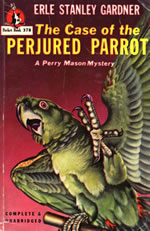The Case of the Perjured Parrot
 Cover Artist:
Cover Artist: not identified
By: Gardner, Erle Stanley
Publisher: Pocket Books, Inc. (378)
Place of Publication:New York, NY
Catalog #: Kelley Box 251: PS3513 .A6322 C265 1947
Contributor:
M. Moran
General
Era: 1930s
Author as on Cover: Erle Stanley Gardner
Publication:1947
Original Date: 1939
Setting: urban; a large city where Perry Mason lives and works and a smaller city where his client lives
Plot Summary
When a wealthy man is murdered, his son asks Perry Mason to help find the murderer and keep the widow from taking control of the estate. The only witness to the murder is a parrot. The plot gets complicated when a second parrot is discovered which seems to name the killer, "Helen," -- the widow's name, but another Helen shows up, claiming she was recently married to the deceased man. Circumstantial evidence points to the second Helen as the killer, and Perry Mason sets out to clear her and locate the real murderer.
Major Characters
Perry Mason adult male, middle-aged, described by Gardner as an "intrepid, dramatic, elusive fighter, whose cause is never lost," tends to bend the rules a little, but never acts illegally, defense attorney
Paul Drake adult male, "long, laconic, and loyal, willing to toss his natural caution to the winds in the service of Perry Mason," owner of the Drake Detective Agency
Richard Waid adult male, blonde, early 30s, wears horn-rimmed glasses, "erstwhile secretary to Fremont C. Sabin, whose conscience is his guide, when convenient," check forger
Helen Monteith adult female, tall, slender, graceful, self-reliant, probably in her late 30s, librarian, married a man she thinks was Sabin but it turns out to have been his brother
Della Street adult female, late 20s/early 30s, "whose horizon is bounded by that of her chief," Perry Mason's steadfast legal secretary
Helen Watkins Sabin adult female, heavy but not flabby ("her body was hard beef"), shrewish gold-digger, housekeeper for Sabin, she connives to have him marry her and is after as much money as she can get from him
Fremont Sabin adult male, eccentric, multimillionaire, believes in earning one's own way, interested in observing people from all walks of life, frequented libraries, browsed through books, enjoyed retreating to his cabin to watch nature
Sergeant Holcomb adult male, police detective, dislikes Perry Mason to the highest degree, determined to catch Mason straying outside the law
Sheriff Barnes adult male, big, late 50s, "who moved with slow efficiency," fair in dealing with Mason, embarassed by Holcomb's attitude
Weapons
gun
Level of Violence
violence occurs off stage
Sexuality
sexuality is not evident in this story. Helen Monteith tells Della the sad story of her youthful romantic affair and explains why she fell in love with an older man. Perry and Della may place an affectionate arm on each other, but that's the extent of their romance.
Gender Roles
typical 1930s gender roles; Helen Monteith is a librarian, Della a secretary. The police, coroner and prosecutor are all male.
Ethnicity
not a factor.
Alcohol/Drug Abuse
no role in the novel. The sheriff rolls his own cigarette and at one point chews tobacco. A cigarette stub is found in a cabin where phone tapping took place. Even Perry Mason doesn't smoke as he has in other cases.
Law Enforcement
Sergeant Holcomb and district attorney Sprague are both belligerent, loud men determined to thwart Perry Mason at any cost. Of course, Perry shows them up once again in the final confrontation. Sheriff Barnes appears in the best light -- honest but simple, hard-working, and friendly toward Mason.
Added Features
two instances of interest: in the opening pages, Perry talks to Della about his defense philosophy: "Crime is personal. Evidence of crime is impersonal. I never take a case unless I'm convinced my client was incapable of committing the crime charged. Once I've reached that conclusion, I figure there must be some discrepancy between the evidence and the conslusions the police have drawn from the evidence. I set out to find them." And the difference between detectives and lawyers: "A detective gathers evidence....a lawyer interprets the evidence after it's been collected." Later in the book, there is a kind of diatribe about politicians which one assumes Gardner was aiming at contemporary figures. "Take politics, for instance. We can look back at past events, and the deadly significance of those events seems so plain that we don't see how people could possibly have overlooked them. Yet millions of voters, at the time, saw those facts and warped their significance so that they supported erroneous political beliefs. The same is true of the things which are happening at present....twenty years from now even the most stupid high school student can appreciate the importance of those signs and the results which must inevitably have followed. But right now we have some twenty-five million who think another way."
Subject Headings
Detectives, Private/ Law and Lawyers/ Murder/ California/ Mason, Perry
Psychological Elements
the murder is solved with a lot of investigation of the facts by Paul Drake and his operatives, along with Perry's deductions, but the coincidences and red herrings make the case seem somewhat unrealistic. Although Helen Sabin, her son, and some of the other characters are very one-sided, there is no insight into their psychological make-up.
 Cover Artist: not identified
Cover Artist: not identified